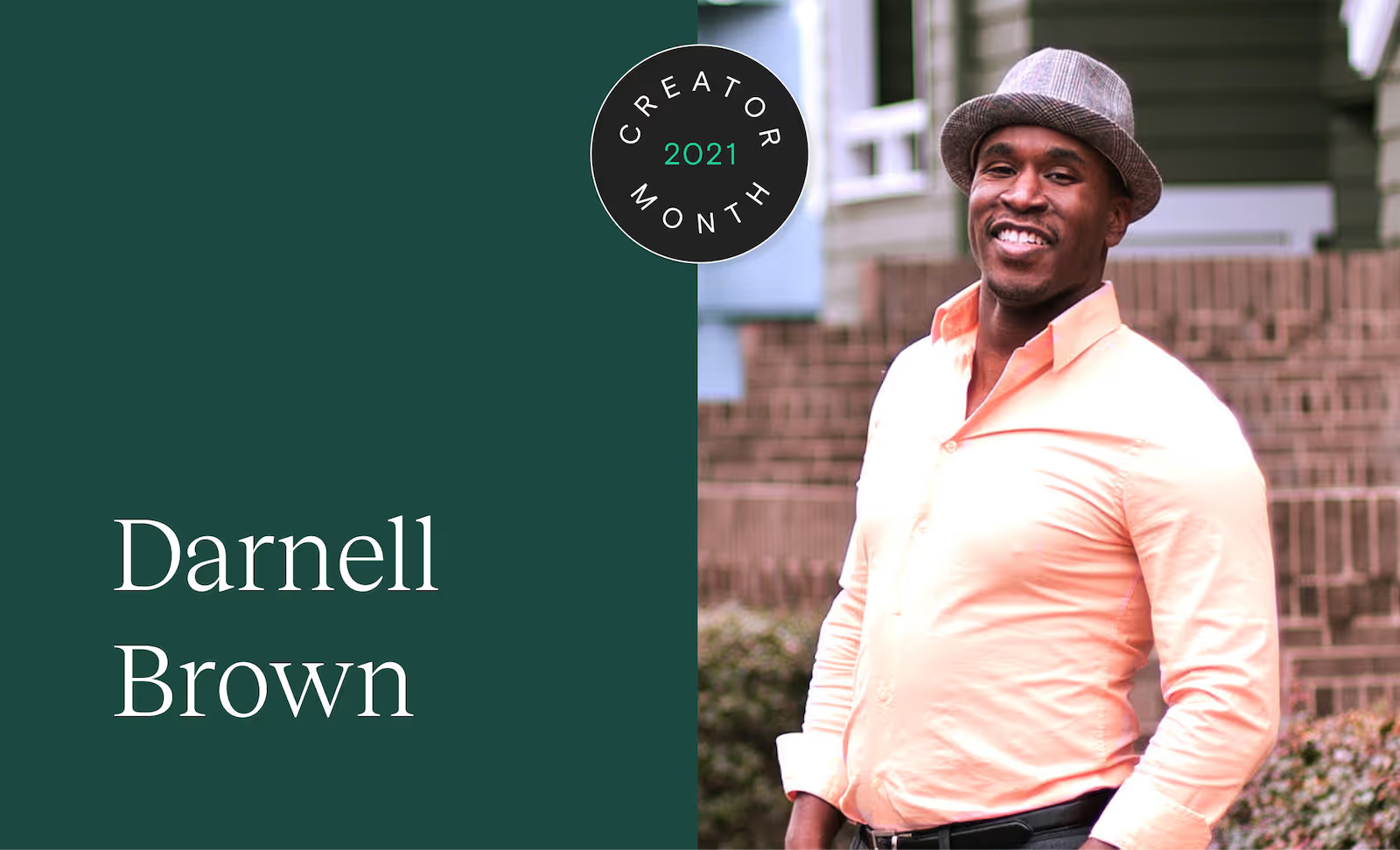The following is a guest post from Teachable creator, Darnell Brown. Darnell is an award-winning certified brand strategist and educator. He helps today’s leaders and experts save time and impact lives through brand clarity, empathy, and strategy. His clients include BAND-AID, Passport Parking, & /dev/color. In honor of Teachable’s Creator Month, in which we celebrate and share the expertise of creators everywhere, Darnell shares his tips for how to start your own business online.
Before we get started, let’s get stopped. It’s time to stop obsessing over your legal business name. And your logo design. And where to host your website. Or whether you still need business cards in the 21st century. Until you’ve done the things in this article, none of that stuff is relevant right now.
To be clear, I do not deny the power that dope brand visuals can have on an audience—my background is in design, after all. I’m just saying, now is not the time to worry about those items. Not yet, anyway. So strap on your seatbelts, and let’s start your own business online with $0 down.
You want to go from start to success with as little resistance as possible, right? OK, well, I’m about to place a wormhole in your observable universe like our future selves did in Interstellar to help get you there. Let’s shave a few lightyears off your travels, shall we? First, we need to find an idea worth investing in. Next, we’re gonna discover the right people to target. Lastly, we’ll clarify what it is you have to offer them.
Step 1. Pick a problem
The number one question you need a crystal clear answer to is: “What problem(s) do I solve?” Everything begins here. It’s the crux of your business, and it’s the thing that gives you purpose. This question has no equal. If success is the omega, the problem you solve is the alpha.
To answer the question above, you’ve got to pick a problem worth building a business around.
There are three parts to this:
- Notice what people are regularly complaining about around you
- Choose a complaint that you’re suited to solve
- Commit to addressing this problem using your current skills
Great news: You won’t have to look far nor hard for complaints. They’re everywhere. Offline and online. And they outnumber solutions. We’re all vocal about the things we despise in life. You just need to intentionally listen out for the problems that keep coming up.
Once you’ve heard the word a good bit, just hone in on one or two problems that really speak to you. Complaints you agree with that also fire you up. Reach in your metaphorical toolkit for anything from your current skill set that qualifies you to present a solution.

Not just your evident, accredited skills, either. Think about your innate gifts, the way you’d contribute to society if you didn’t have to worry about money, the topics people frequently discuss with you, and who people know you as around your ‘hood. It’s good business to find the gold within the mundane or overlooked elements of everyday life.
Visualize it
For instance, you might be a burned-out dental hygienist that does some woodworking on the side—who’s also someone people look to for professional recommendations. While listening to problems, you notice that other people besides you hate taking their vehicle in for service. You start to wonder why a valet service for car care doesn’t exist yet. Perhaps technicians could come to your home and do tune-ups on-site, or they could take it to the dealership for you.
Before shooting this idea down, since you aren’t an app developer, you realize that your time as a dentist literally put you in front of everyone you need to help you get this thing off the ground. Designers. Coders. Investors. It becomes clear that you could assemble a team full of folks you’ve already met as a dentist to build a car care platform for you.
In this example, one of your most undervalued assets is your network. Your secret superpower is you’re an excellent connector. Leaning into your non-obvious gifts could afford you the luxury of doing more of what you love, even if you never want to turn your hobby into a business. Peep my Pick a Problem Worksheet I’ve put together to help you find your superpower (and problem). It’s yours to download for free.
You can find tons of problems on:
Set up free accounts on a few of those platforms, hop in the forums that align with your interests, and just read the rooms. Your only job in this phase is to absorb what’s being said.
Step 2. Define your consumer
After choosing the problem you’re going to build a business around, your next power move is to specify who has that problem. That “who” has many names: ideal avatar, customers, target audience, buyers, etc. They’re all the same thing in this context. To define your consumer, you must:
- Identify a group of people who all have that same problem
- Get to know them by listening to how they express the problem
- Let them know you’re cooking up a solution they’ll love
The dope part is that you’ll likely already have some consumer insights from Step 1 because you can see some info on who said what when they voiced their opinion. Now it’s about designing a baseline personal profile for the type of person who severely has that issue and would therefore be most grateful and loyal to the entity that fixes it for them the best.
Ears to the ground
Knowing their demographics alone won’t cut it. You need psychographics as well: what your consumer’s relationships are like, whether they have kids, what their hobbies are, their goals, motivations, etc. Basically, you should know them like you know your closest friends. Condense them into a singular avatar. Then give them a name to personalize them even further. And whether this ideal consumer is a complete creation is irrelevant. The point is to develop a North Star that you have an affinity for.
Listen deeply to what your audience is saying. Often, those we hope to serve describe their problems differently than we do, so we explain our offers in a way that doesn’t stick. Your audience won’t create your business for you, nor flat-out tell you precisely what they need. It’s on you to be a strong interpreter of words, mannerisms, facial expressions, and bodily gestures. Basically, you’re gonna have to get your Batman on and become the world’s greatest detective if you want to build an innovative, lean business without a down payment.
A welcome solution
Once you know your consumer and can speak their language, it’s time to begin validating your offer. Tell your audience that you’re working on something that will solve their problem and ask if it’s ok for you to reach out once it’s ready, so they can test it for themselves. They’ll be thrilled to know that their prayers are being answered, and you’ll be ahead of the game with a database of potential customers. This will give you momentum and accountability, great motivators to keep you going.
Carrying on the scenario from above, maybe your defined consumer would be work-from-home moms in their 30’s, with toddlers, traveling spouses, and packed schedules.
They might describe their problem as: “I don’t have the time to get my oil changed, and tires rotated. My babysitter bailed, and there’s no way my kids will behave for two hrs at the dealership.” As we can see, that’s not a very constructive or enlightening statement at first glance. But when you dig deeper, there’s hidden value. Her real issue is that car maintenance is a huge inconvenience.
Pre-selling your offer might sound like, “I’m working on an app that will allow you to schedule on-demand car maintenance from your smartphone. Is it OK if I message you once it’s ready so that we can see if it improves your situation?” She’ll be like, “Ummm, yeah!” And you’ll feel all warm and fuzzy inside by having your idea immediately validated.
You can learn more about your target audience through:
- 1:1 audio/video calls
- virtual coffee dates
- VideoAsks
- group webinars
- conversational surveys
- social media DMs
- emails
Test several ways to chat with your consumer and use the few that yield the most engagement. It’s critical in this stage that you meet them where they already hang out vs. the platforms you prefer to use. You’ll encounter less resistance when you make things easy and swift for your audience to give you the insights you need to model your offer.
Your business must be hyper-passionate about taking your consumer from where they are to where they want to be. No need to feel overwhelmed. Learn the ways of the force with this free Define Your Consumer Worksheet I put together for you.
Step 3. Clarify your offer
Once you’ve chosen the problem that will fuel your brand and defined the group of folks your product/service will serve, it’s time to ready your brand pitch. This is also commonly referred to as a “tagline,” “elevator pitch,” or “unique value proposition.”
The goal is to articulate your business’s value in a way that is both succinct and descriptive. We want folks to get the gist of what you’re all about in the least amount of time.

To arrive at yours, we’ve got to:
- Highlight the problem you solve in the language of your audience
- Outline how your consumer will benefit from using your solution
- Describe who your offer is a perfect fit for
It’s here that everything coalesces into a proper statement that sums up what you bring to the table. The problem, the audience, and the offer get rolled into one.
The homework we did in Step 2 comes into play in that we use how your consumer has defined the problem, which is often in the form of a complaint, to summarize what they’re really going through. Your “how” becomes a way to appease that problem, which is why it’s essential to include it within your offer.
- The what = their problem
- The how = your solution
- The who = your audience
Put them all together, and we arrive at your offer.
Tackle the following items chronologically to help get you there:
- How does your target consumer explain their problem?
- What are they really trying to say?
- So what do they actually need?
- Explain how your product/service will help your target audience in a clear way that they’ll understand.
- Good, now get even more specific.
Steer clear of talking about the features of your offer: its bells and whistles, the tangible attributes, the nutritional facts, etc. Focus instead on the benefits your consumer will experience in using your offer: how they’ll be transformed, the tangible results, what’s in it for them, etc. Don’t try to sell a product. Sell the lifestyle or a future feeling your audience craves.
A bevy of benefits
Divorce yourself from falling into the trap that anyone is ever going to care about your idea/product/service as much as you do. Of course, your offer should deliver on its promise, but that’s the lowest hanging fruit. You must also persuade folks to take action, and one of the brilliant ways to do that is by appealing to what they value. Generally, people are looking for convenience and/or relief. Explore where your product fits on that scale.
Going back to that example, maybe you interpret their problem as, “Car maintenance sucks. The upsells, the wait times, etc. Especially for women, who techs assume are naive about what’s under their hood.”
Your solution to that might sound like, “For one low price, we’ll pick up your car from wherever you are, get it serviced, bathed, vacuumed, and delivered back to you the same day.” (The hands-off maintenance is already a fantastic solution, but by cleaning it as well, you’re sweetening the deal.) We tee everything up with the niche you’re serving for a clarified offer like, “We bring valeted car care to busy moms, giving them one less thing to worry about.” Succinct. Descriptive. Compelling.
Say it, simply
In creating new things, we can tend to over-explain what we do or sell. We get curious looks because they don’t quite get it. Usually, the issue lies with us entrepreneurs: we simply aren’t talking in the language of our audience. The cure is to appropriate their language within our offer to explain our solution in a benefit-driven way they can grasp.
Subconsciously, when done right, this gets your consumer to think, “Oh wow, they know my problem because they’ve explained it the way I do, and they’ve got something that fixes it, so this product must be right for me!” Meet them where they are, both physically and in terms of talking about things the way they already do. This lowers that trust barrier so that people have a reason to give you a shot.
Get your free copy of my Clarify Your Offer Worksheet to guide you through the questions you need to answer to arrive at yours.
{{firstdigital-component="/blog-shortcodes/blog-popup"}}
Putting it all together
Regardless of your industry, profession, or idea, to start your own for-profit business online with $0 down, you would do well to follow these three steps before you do anything else.
- Pick a problem to build your brand around. Find a complaint out of the many out here in the world today that irks you, of which you’re also qualified to soothe based on skills you already possess. Treat it as your anchor and purpose, then focus on solving it.
- Define the ideal person/people you’ll serve. Anyone who has the same problem is a potential customer. Familiarize yourself with how they articulate this problem and get to know them further through questioning and researching. Pre-sell your offer by letting them know you’re cooking up a solution.
- Clarify your offer to earn buzz and trust. Explain the problem in a way your audience will understand by building off how they’ve expressed their frustration. Let them know how your offer will relieve that problem and put it all together into a compelling pitch.
After you’ve followed the steps above, then you can brainstorm names, hire designers and developers, and obsess over your brand colors. Until that point, concern yourself with knowing the problem(s) you solve and who you’re solving it for, which will cost you largely nothing but your time.
Successful entrepreneurs and businesses are the ones who know and serve their customers better than everyone else. They’re really just some of the world’s best problem-solvers. Now that you have a wormhole to a similar destination, what’s to stop you from joining the ranks? Godspeed and safe travels, friend.
Join more than 150,000 creators who use Teachable to make a real impact and earn a real income.


.png)




